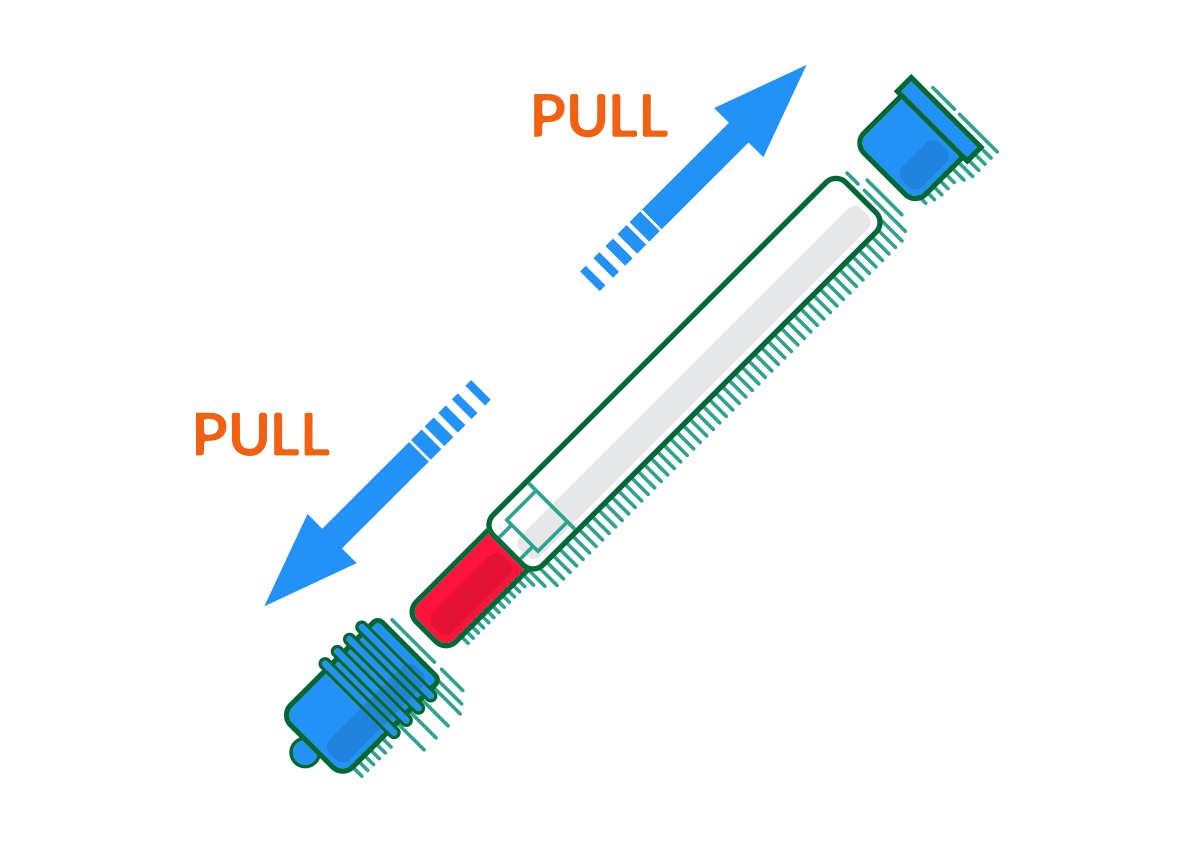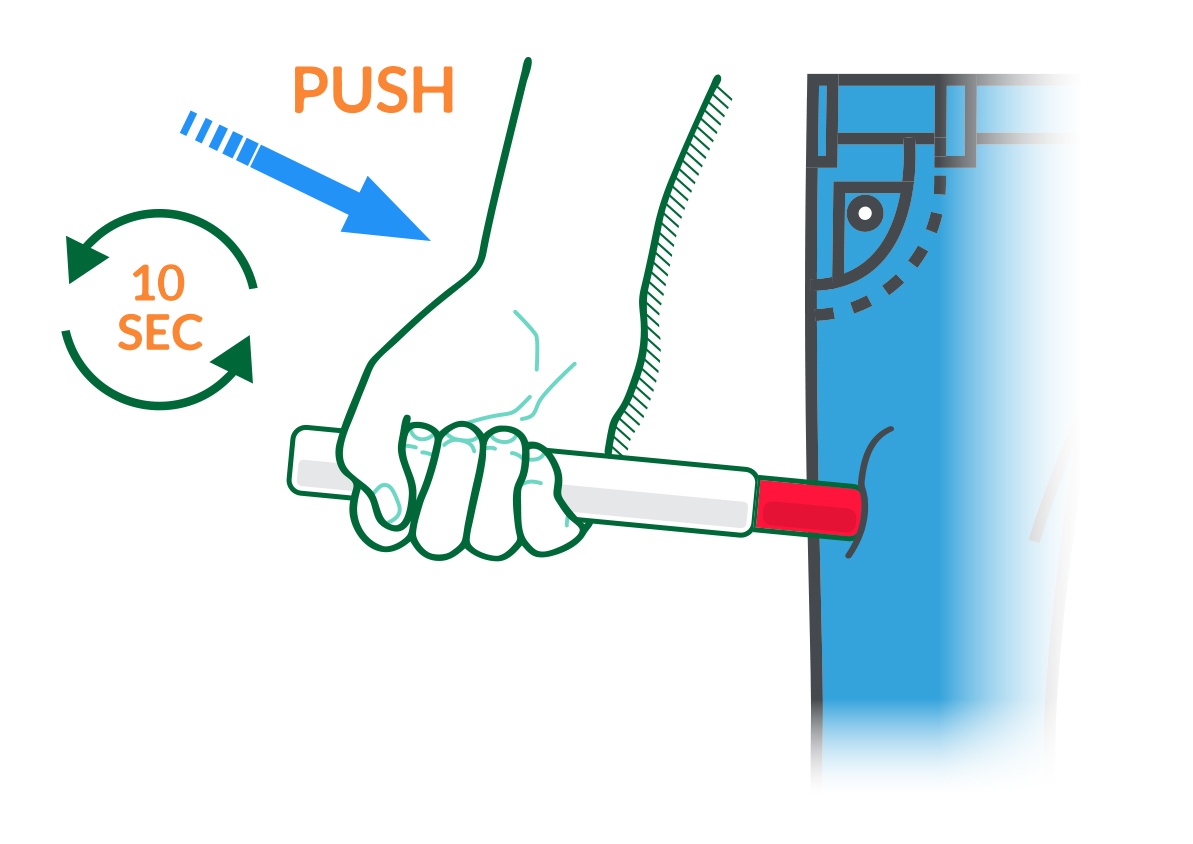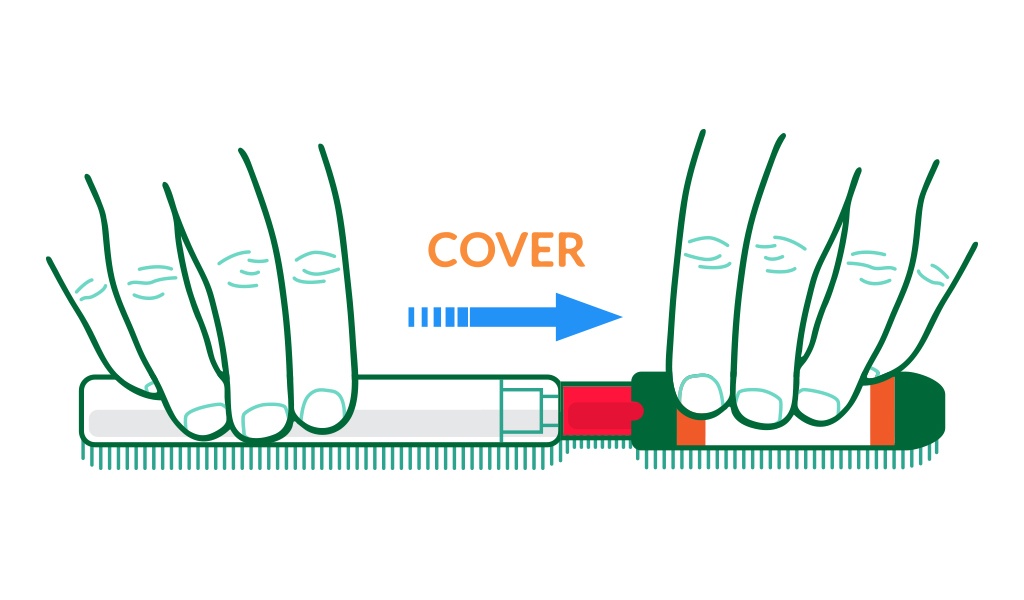MENU
How To Use
To start, ask your healthcare provider to show you the proper way to use your epinephrine injection, USP auto-injector. Please read the Patient Information Leaflet carefully after filling and refilling your prescription. There may be new information in this leaflet that you or those who you trust to administer injections (parents, caregivers, school nurses) should know. Reading the leaflet ensures you know how to use the injector during a severe allergic reaction, and it contains details beyond those in the quick-reference instructions. In addition, our free Product Trainers let you practice using an injector properly without an injection occurring.
How to Use
To start, ask your healthcare provider to show you the proper way to use your epinephrine injection, USP auto-injector. Please read the Patient Information Leaflet carefully after filling and refilling your prescription. There may be new information in this leaflet that you or those who you trust to administer injections (parents, caregivers, school nurses) should know. Reading the leaflet ensures you know how to use the injector during a severe allergic reaction, and it contains details beyond those in the quick-reference instructions. In addition, our free Product Trainers let you practice using an injector properly without an injection occurring.
Please watch the instructional video
Take the time to view this now, so you’ll know exactly how to use your epinephrine auto-injector in an emergency. This information does not replace talking with your doctor about your medical condition or your treatment.
Instructions for Using the Epinephrine Injection, USP Auto-Injector for both the epinephrine auto-injector 0.15 mg and the epinephrine auto-injector 0.3mg.

Figure A
STEP 1. Prepare epinephrine injection, USP auto-injector for injection
Remove epinephrine injection, USP auto-injector from its protective carrying case. Pull off blue end caps; you will now see a red tip. Grasp the auto-injector in your fist with the red tip pointing downward. See Figure A.
Note
The needle comes out of the red tip. To avoid an accidental injection, never put your thumb, fingers, or hand over the red tip. If an accidental injection happens, get medical help right away.

Figure B
STEP 2. Administer epinephrine injection, USP auto-injector
If you are administering epinephrine injection, USP auto-injector to a young child, hold the leg firmly in place and limit movement prior to and while administering an injection. Put the red tip against the middle of the outer thigh (upper leg) at a 90° angle (perpendicular) to the thigh. Press down hard and hold firmly against the thigh for approximately 10 seconds to deliver the medicine. See Figure B. The auto-injector is designed to work through clothing.
Only inject into the middle of the outer thigh. Do not inject into any other part of the body. Remove epinephrine injection, USP auto-injector from the thigh. Massage the area for 10 seconds. Check the red tip. The injection is complete and you have received the correct dose of the medicine if you see the needle sticking out of the red tip. If you do not see the needle repeat Step 2.
STEP 3.
Get emergency medical help right away.
You may need further medical attention. You may need to use a second epinephrine injection, USP auto-injector if symptoms continue or recur. Only a healthcare provider should give additional doses of epinephrine if you need more than 2 injections for a single anaphylaxis episode.

Figure C
STEP 4. After use/disposal
Carefully cover the needle with the carrying case. Lay the labeled half of the carrying case cover down on a flat surface. Use one hand to carefully slide the end of the auto-injector, needle first, into the labeled carrying case cover. See Figure C.

Figure D
After the needle is inside the labeled cover, push the unlabeled half of the carrying case cover firmly over the non-needle end of the auto-injector. See Figure D. Take your used epinephrine injection, USP auto-injector with you when you go to see a healthcare provider. Tell the healthcare provider that you have received an injection of epinephrine. Show the healthcare provider where you received the injection. Give your used epinephrine injection, USP auto-injector to the healthcare provider for inspection and proper disposal.
Ask for a refill, if needed. Each single-dose epinephrine injection, USP auto-injector is designed to provide accurate delivery of a complete dose of epinephrine when it is needed most.
Since you cannot predict when a life-threatening allergic reaction (anaphylaxis) will occur, carry your epinephrine, USP auto-injector at all times.
Remember, after using the epinephrine, USP auto-injector, you must obtain emergency medical treatment right away.
Notes
-
-
-
-
Epinephrine injection, USP auto-injector is a single-use injectable device that delivers a fixed dose of epinephrine. The auto-injector cannot be reused. Do not attempt to reuse epinephrine injection, USP auto-injector after the device has been activated. It is normal for most of the medicine to remain in the auto-injector after the dose is injected. The correct dose has been administered if you see the needle sticking out of the red tip.
-
-
-
A separate epinephrine injection, USP auto-injector Trainer is available. The epinephrine injection, USP auto-injector Trainer has a beige color. The beige epinephrine injection, USP auto-injector Trainer contains no medicine and no needle. Practice with your epinephrine injection, USP auto-injector Trainer, but always carry your real epinephrine injection, USP auto-injector in case of an allergic emergency.
-
-
-
If you will be administering epinephrine injection, USP auto-injector to a young child, ask your healthcare provider to show you how to properly hold the leg in place while administering a dose.
-
-
-
Do not try to take the epinephrine injection, USP auto-injector apart.
-
-
-
Tips
-
-
- Do NOT remove the blue caps until you’re ready to use the epinephrine auto-injector.
-
- Keep your epinephrine injection, USP auto-injector at room temperature: 68°-77°F (20°-25°C). Avoid exposing to extreme heat or cold. For example, do not store in your vehicle’s glove box or in the refrigerator or freezer.
-
- Protect epinephrine injection, USP auto-injector from light.
-
- Check your epinephrine injection, USP auto-injector regularly. The solution should be clear. Replace it if it has expired, or if the medicine is cloudy, discolored (pinkish or brown), or has particles in it.
-
- The epinephrine injection, USP auto-injector is not waterproof, so if it is ever submerged in water or any other liquid, it cannot be used. If this occurs, obtain a replacement.
-
- In the case of accidental injection, go immediately to the nearest emergency room.
-
- Be sure to read the Patient Information Leaflet carefully.
-
Notes
-
-
-
-
Epinephrine injection, USP auto-injector is a single-use injectable device that delivers a fixed dose of epinephrine. The auto-injector cannot be reused. Do not attempt to reuse epinephrine injection, USP auto-injector after the device has been activated. It is normal for most of the medicine to remain in the auto-injector after the dose is injected. The correct dose has been administered if you see the needle sticking out of the red tip.
-
-
-
A separate epinephrine injection, USP auto-injector Trainer is available. The epinephrine injection, USP auto-injector Trainer has a beige color. The beige epinephrine injection, USP auto-injector Trainer contains no medicine and no needle. Practice with your epinephrine injection, USP auto-injector Trainer, but always carry your real epinephrine injection, USP auto-injector in case of an allergic emergency.
-
-
-
If you will be administering epinephrine injection, USP auto-injector to a young child, ask your healthcare provider to show you how to properly hold the leg in place while administering a dose.
-
-
-
Do not try to take the epinephrine injection, USP auto-injector apart.
-
-
-
Tips
-
-
- Do NOT remove the blue caps until you’re ready to use the epinephrine auto-injector.
-
- Keep your epinephrine injection, USP auto-injector at room temperature: 68°-77°F (20°-25°C). Avoid exposing to extreme heat or cold. For example, do not store in your vehicle’s glove box or in the refrigerator or freezer.
-
- Protect epinephrine injection, USP auto-injector from light.
-
- Check your epinephrine injection, USP auto-injector regularly. The solution should be clear. Replace it if it has expired, or if the medicine is cloudy, discolored (pinkish or brown), or has particles in it.
-
- The epinephrine injection, USP auto-injector is not waterproof, so if it is ever submerged in water or any other liquid, it cannot be used. If this occurs, obtain a replacement.
-
- In the case of accidental injection, go immediately to the nearest emergency room.
-
- Be sure to read the Patient Information Leaflet carefully.
-
IMPORTANT SAFETY INFORMATION
What is the most important information I should know about epinephrine injection, USP auto-injector?
-
- Epinephrine injection, USP auto-injector contains epinephrine, a medicine used to treat allergic emergencies (anaphylaxis). Anaphylaxis can be life-threatening, can happen within minutes, and can be caused by stinging and biting insects, allergy injections, foods, medicines, exercise or other unknown causes. Symptoms of anaphylaxis may include:
- trouble breathing
- wheezing
- hoarseness (changes in the way your voice sounds)
- hives (raised reddened rash that may itch)
- severe itching
- swelling of your face, lips, mouth, or tongue
- skin rash, redness, or swelling
- fast heartbeat
- weak pulse
- feeling very anxious
- confusion
- stomach pain
- losing control of urine or bowel movements (incontinence)
- diarrhea or stomach cramps
- dizziness, fainting, or “passing out” (unconsciousness).
- Always carry your epinephrine injection, USP auto-injector with you because you may not know when anaphylaxis may happen. Talk to your healthcare provider if you need additional units to keep at work, school, or other locations. Tell your family members, caregivers, and others where you keep your epinephrine injection, USP auto-injector and how to use it before you need it. You may be unable to speak in an allergic emergency.
- When you have an allergic emergency (anaphylaxis)
- Use epinephrine injection, USP auto-injector right away.
- Get emergency medical help right away. You may need further medical attention. You may need to use a second epinephrine injection, USP auto-injector if symptoms continue or recur. Only a healthcare provider should give additional doses of epinephrine if you need more than 2 injections for a single anaphylaxis episode.
What is epinephrine injection, USP auto-injector?
- Epinephrine injection, USP auto-injector is a disposable, prefilled automatic injection device (auto-injector) used to treat life-threatening, allergic emergencies including anaphylaxis in people who are at risk for or have a history of serious allergic emergencies. Each device contains a single dose of epinephrine.
- Epinephrine injection, USP auto-injector is for immediate self (or caregiver) administration and does not take the place of emergency medical care. You should get emergency medical help right away after using epinephrine injection, USP auto-injector.
- Epinephrine injection, USP auto-injector is for people who have been prescribed this medicine by their healthcare provider.
What should I tell my healthcare provider before using epinephrine injection, USP auto-injector? Before you use epinephrine injection, USP auto-injector, tell your healthcare provider about all your medical conditions, especially if you:
- have heart problems or high blood pressure
- have diabetes
- have thyroid problems
- have asthma
- have a history of depression
- have Parkinson’s disease
- have any other medical condition
- are pregnant or plan to become pregnant
- are breastfeeding or plan to breastfeed
Tell your healthcare provider about all the medicines you take, including prescription and over-the-counter medicines, vitamins and herbal supplements. Tell your healthcare provider of all known allergies. Especially tell your healthcare provider if you take certain asthma medicines.
How should I use epinephrine injection, USP auto-injector?
- Each epinephrine injection, USP auto-injector contains only 1 dose of medicine.
- Epinephrine injection, USP auto-injector should only be injected into the middle of the outer thigh (upper leg). It can be injected through clothing, if needed.
- Read the Instructions for Use in the Patient Information Leaflet for information about the right way to use epinephrine injection, USP auto-injector.
- Your healthcare provider will show you how to safely use the epinephrine injection, USP auto-injector.
- Use epinephrine injection, USP auto-injector exactly as your healthcare provider tells you to use it.
What are the possible side effects of epinephrine injection, USP auto-injector? Epinephrine injection, USP auto-injector may cause serious side effects.
- Epinephrine injection, USP auto-injector should only be injected into the middle of your outer thigh (upper leg). Do not inject epinephrine injection, USP auto-injector into your veins, buttocks, fingers, toes hands or feet.
If you accidently inject epinephrine injection, USP auto-injector into any other part of your body, go to the nearest emergency room right away. Tell the healthcare provider where on your body you received the accidental injection.
- Rarely patients who use epinephrine injection, USP auto-injector may develop infections at the injection site within a few days of an injection. Some of these infections can be serious. Call your healthcare provider right away if you have any of the following at an injection site:
- redness that does not go away
- swelling
- tenderness
- the area feels warm to the touch
- If you inject a young child with epinephrine injection, USP auto-injector, hold their leg firmly in place before and during the injection to prevent injuries.
- If you have certain medical conditions, or take certain medicines, your condition may get worse or you may have more or longer lasting side effects when you use epinephrine injection, USP auto-injector. Talk to your healthcare provider about all your medical conditions.
Common side effects of epinephrine injection, USP auto-injector include
- faster, irregular or “pounding” heartbeat
- sweating
- headache
- weakness
- shakiness
- paleness
- feelings of over excitement, nervousness, or anxiety
- dizziness
- nausea or vomiting
- breathing problems
These side effects may go away with rest. Tell your healthcare provider if you have any side effect that bothers you or that does not go away. These are not all the possible side effects of epinephrine injection, USP auto-injector. For more information, ask your healthcare provider or pharmacist. Call your healthcare provider for medical advice about side effects. You may report side effects to FDA at 1-800-FDA-1088.
Keep epinephrine injection, USP auto-injector and all medicines out of the reach of children.
What are the ingredients in epinephrine injection, USP auto-injector? Active Ingredient: epinephrine Inactive Ingredients: sodium chloride, chlorobutanol, sodium bisulfite, hydrochloric acid and sodium hydroxide, and water.
You are encouraged to report negative side effects of prescription drugs to the FDA. Visit www.fda.gov/medwatch or call 1-800-FDA-1088. To report SUSPECTED ADVERSE REACTIONS, contact Amneal Pharmaceuticals LLC at 877-835-5472, option 1 or email DrugSafety@amneal.com. Please click here for full Prescribing Information including the Patient Information Leaflet.
For more information and video instructions on the use of epinephrine injection, USP auto-injector, go to www.epinephrineautoinject.com or call 1-800-934-6729.
Indication: The epinephrine injection, USP auto-injector is a disposable, prefilled automatic injection device (auto-injector) used to treat life-threatening, allergic emergencies including anaphylaxis in people who are at risk for or have a history of serious allergic emergencies.
- Epinephrine injection, USP auto-injector contains epinephrine, a medicine used to treat allergic emergencies (anaphylaxis). Anaphylaxis can be life-threatening, can happen within minutes, and can be caused by stinging and biting insects, allergy injections, foods, medicines, exercise or other unknown causes. Symptoms of anaphylaxis may include:
IMPORTANT SAFETY INFORMATION
What is the most important information I should know about epinephrine injection, USP auto-injector?
- Epinephrine injection, USP auto-injector contains epinephrine, a medicine used to treat allergic emergencies (anaphylaxis). Anaphylaxis can be life-threatening, can happen within minutes, and can be caused by stinging and biting insects, allergy injections, foods, medicines, exercise or other unknown causes. Symptoms of anaphylaxis may include:
- trouble breathing
- wheezing
- hoarseness (changes in the way your voice sounds)
- hives (raised reddened rash that may itch)
- severe itching
- swelling of your face, lips, mouth, or tongue
- skin rash, redness, or swelling
- fast heartbeat
- weak pulse
- feeling very anxious
- confusion
- stomach pain
- losing control of urine or bowel movements (incontinence)
- diarrhea or stomach cramps
- dizziness, fainting, or “passing out” (unconsciousness).


